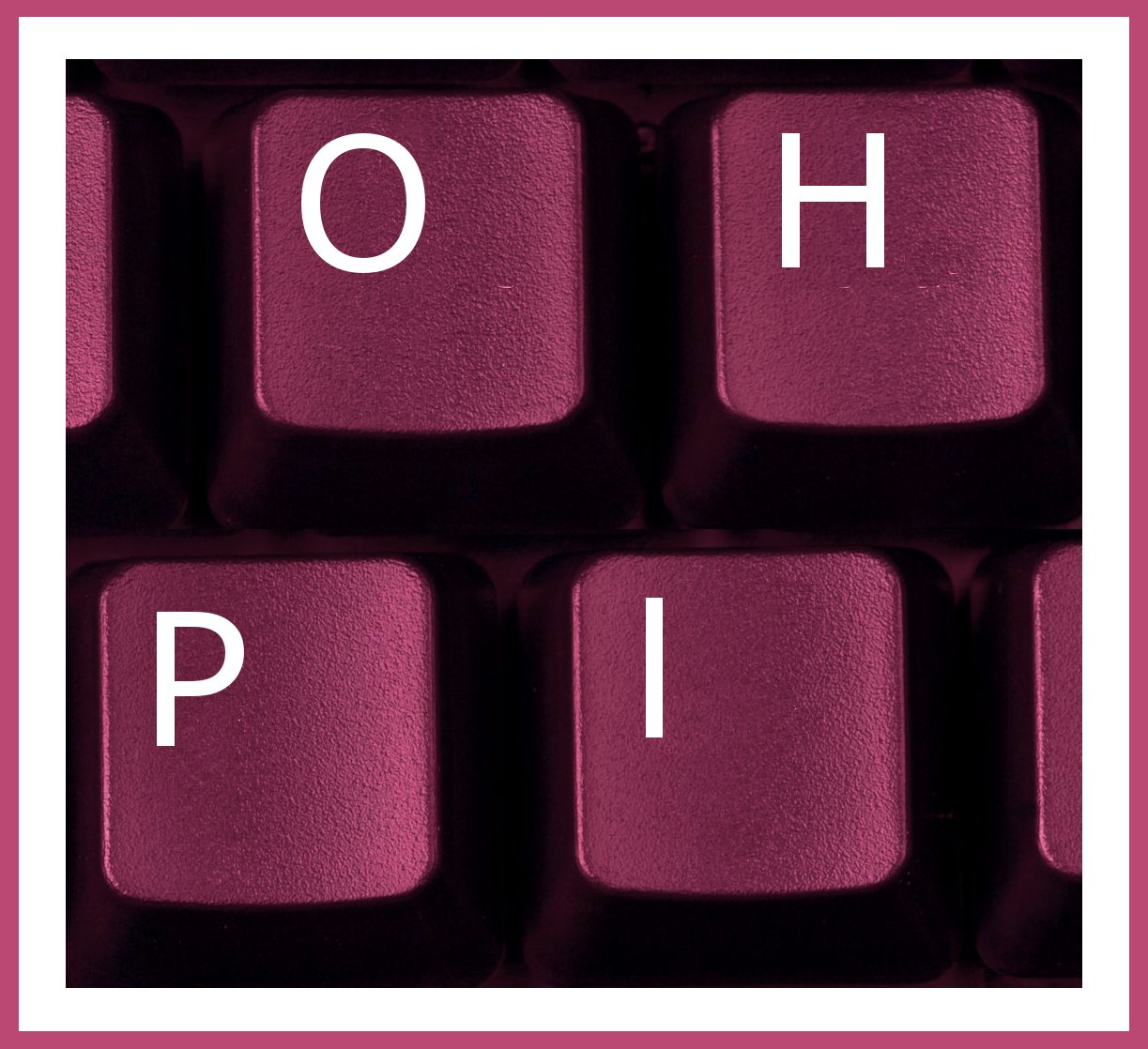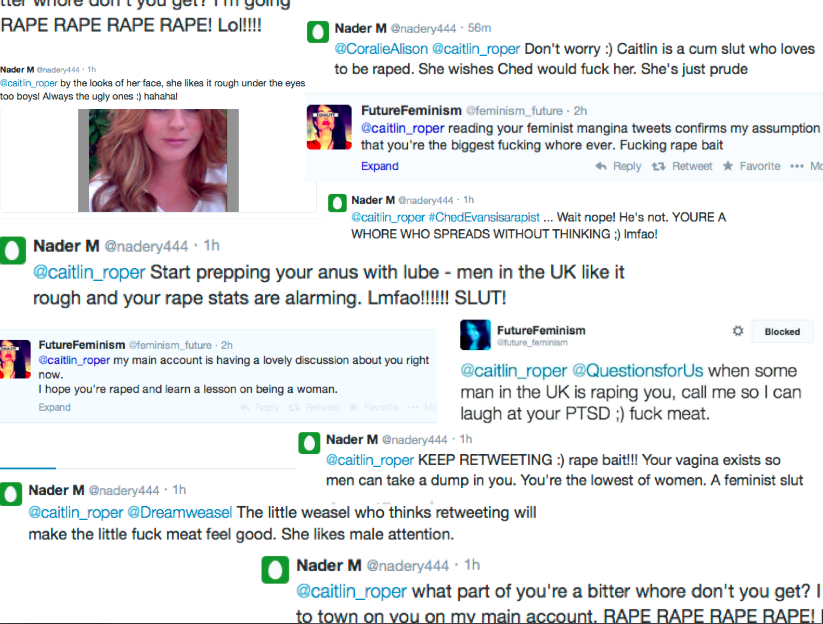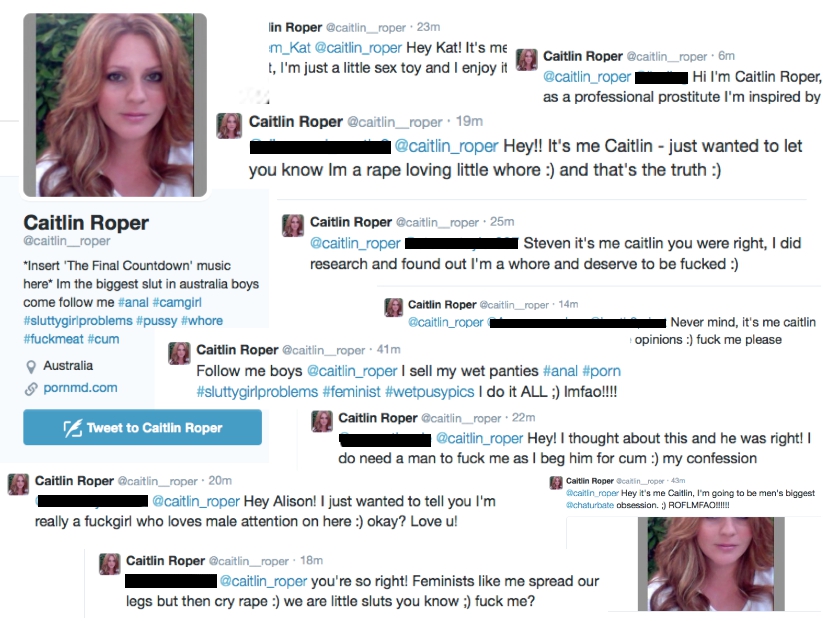On International Women’s Day, the Australian feminist campaigner Caitlin Roper shares her experiences of online misogyny to illustrate its aims, modus operandi and fall outs.
Recently the prominent feminist Jessica Valenti confessed in a Washington Post article that given the nonstop harassment that feminist writers face online, if she could start over, she might prefer to be completely anonymous. The article stated that the psychological damage caused by the constant, violent and sexualized hatred is leading many women to recede from the online fight.
As a feminist campaigner who has been the victim of various online harassment campaigns by men who oppose my stand, I know what Valenti’s talking about.
I am a part of Collective Shout, a grassroots organization campaigning against the objectification of women and sexualisation of girls in media, advertising and popular culture. As a result, I have encountered the full spectrum of online misogyny: from general hostility, sexist slurs, death threats, rape threats to attempts at serious reputational damage through impersonation. The aim of the harassment is to get me to voluntarily quit the campaign.
Silencing women’s voices is the straightforward aim of online misogyny. Social and digital media is where we live out our social, professional and political lives. We make friends, share personal stories, build professional networks, participate in discussions and debates, and make a case for our own rights and the rights of others. But if you are a woman, be warned. Your gender is your weakest link. It will be used against you to push you out of the online space.
Sometimes, women don’t even have to be outspoken champions to be targeted. It is just enough that they are women participating in the digital space to be harassed. As this recent article exploring internet trolling revealed, some trolls are simply looking for a reason to harass you, and your gender is reason enough.
This article presents a number of different ways in which social and digital media platforms are used to insult, humiliate, threaten and harm women, and the abject failure of the law enforcement and social media platforms to recognize the real harm caused by such online expressions of violence against women.
Sexist Slurs
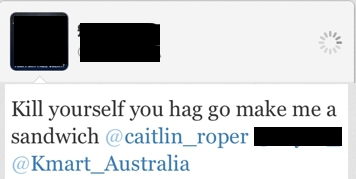


Sexist slurs include language and name calling that is used to demean and denigrate women (e.g. bitch, slut, c*nt etc) or sexist jokes in which women are diminished to sexist stereotypes with their capacities limited to domestic labour and providing sexual gratification to men (e.g. the regularly encounted “Go make me a sandwich”, Steak and Blowjob day “jokes”.)
Sexist slurs are used to undermine women’s standing, as if being female makes them less worthy of being heard and of participating in the public sphere.
Unsolicited content of a sexual nature
 Misogynistic hate speech also includes unwanted sexual comments directed to women. This can take the form of unsolicited comments and questions of sexual nature from male strangers, for example, asking about a woman’s sex life or sexual preferences. These often include unwanted sexual images from men, such as, their erect penis or images of them performing sexual acts.
Misogynistic hate speech also includes unwanted sexual comments directed to women. This can take the form of unsolicited comments and questions of sexual nature from male strangers, for example, asking about a woman’s sex life or sexual preferences. These often include unwanted sexual images from men, such as, their erect penis or images of them performing sexual acts.
These comments make it impossible for a woman who is being targeted to engage with social media without the fear that the next message they receive will be one of abuse. The aim here is to undermine women’s feeling of safety and security online, and to make it clear that women are not welcome or wanted.
Threats of rape or physical violence
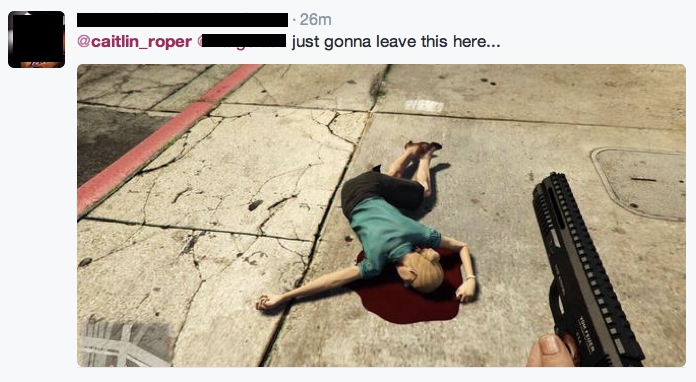 Many women report frequent online threats of rape or physical violence from men. This is particularly targeted at feminist campaigners or women who speak out on other controversial issues. Some men feel so threatened by these women’s voices that they resort to threats of physical violence against them.
Many women report frequent online threats of rape or physical violence from men. This is particularly targeted at feminist campaigners or women who speak out on other controversial issues. Some men feel so threatened by these women’s voices that they resort to threats of physical violence against them.
Threats are also made by sending women distressing images of extreme violence, and jokes and memes about beating and raping women. A recent example of this was when one of my colleagues was sent an image of her face superimposed onto the image of a dead woman lying in a pool of blood. We were, in this case, targeted for highlighting violence against women in the popular video game Grand Theft Auto V.
It is true that, more often than not, such men may not have the intention or the ability to carry out these threats. But as the Elliot Roger massacre in Santa Barbara indicates, there are a small number of mentally unstable people out there who may turn their threats to action. How is one to know when a threat is empty and when there is genuine intent behind them? Can you blame someone who is being targeted like this for choosing not to play this game of Russian Roulette and instead retreat? Such hate speech, whether made with genuine intent or not, is a silencing tactic.
Here is a compilation of some of the rape threats that I received when campaigning for Sheffield United not to reinstate the British soccer player and convicted rapist Ched Evans.
Impersonation
Another frightening tactic used by men is using a woman’s name and image and setting up a fake social media profile. It is aimed at causing reputational damage, social and professional embarrassment and undermining one’s campaigning efforts. This is a particularly popular option on Twitter, where setting up an account is easy but the reporting structure provides few roadways to report fake profiles and get them removed.
I have personally experienced such an attack, where my name and image was appropriated for a fake account offering sex to men online. Here are screenshots of some of what was tweeted in my name. Note the fake account’s use of a double underscore in the name, but how the comments were then Tweeted to my real account (with a single underscore) to ensure I’d see them.
Another online bullying tactic is “doxxing”, which involves publicly releasing a victim’s personal information and contact details online. Doxxing has been used as a form of public vigilantism, but can also be used to target innocent victims. Women fighting for controversial causes are frequent victims of doxxing.
Imagine the distress caused to women who have their home address, their workplace, their children’s names and schools, leaked online for the express purpose of further abuse and harassment.
Revenge Porn
‘Revenge porn’ is the name given to the rising phenomenon of men releasing nude or semi-nude images of women to humiliate and punish them. These photos or videos may have been taken during a consensual intimate moment, but they are subsequently released publicly as revenge against these women when the relationship goes sour.
Equally distressing is the rising trend of uploading and sharing actual photos and footage of women being assaulted and raped online. As if being raped is not traumatic enough, these women now have to face the deep humiliation of having their rape shared publicly or live in the fear of the footage or images surfacing. Women and girls have taken their lives in the aftermath of this devastation.
Response of the Law Enforcement
As a vocal female activist, I’m used to shrugging off the barrage of sexist slurs and physical and sexual threats that I receive online. But when I found myself being impersonated online (as pimping myself), I knew I had to take action. My hands shook and I felt physically ill as I watched tweets from ‘myself’ offering to perform sex acts for strange men on the internet, powerless to stop it.
I felt physically and psychologically threatened enough to take matters to the police. In response, the police officer asked me “Why don’t you just close your account?”. When I explained that I use it for my work, she pressed further- “but why do you need to use it?” The implicit assumption was that if I was being threatened, I should retreat, that it was somehow unreasonable for me to believe I had as much right as anyone to access social media (even in the course of my work) without threats.
I received no assistance from them. It was supportive twitter users who helped me to identify and report the man who created the fake account, and to get Twitter to remove the account.
The experience of my colleagues has not been any better. Talitha Stone, who spoke at OHPI’s launch of its online hate reporting tool http://fightagainsthate.com, approached the law enforcement for help when someone tried doxxing her home address at a time when she was already receiving violent death threats. Instead of helping her, the police sent her away with cyber safety pamphlets.
In fact, around the world, women reporting online threats have been told by police officers to shut down their social media accounts, use “more plain profile pictures”, ‘become anonymous.’ They’ve been told to just “stay off the internet”, even if maintaining an online presence is part of their paid employment. This is arguably the digital version of instructing women not to wear short skirts or walk alone at night.
Police gauge the likelihood of the perpetrator to carry out the threat, and if they suspect it is unlikely, they fail to proceed, despite the fact that under the Commonwealth Criminal Code [Section 474.17] it is an offence to use a carriage service (such as the internet) to “menace, harass or cause offense”. Their response to women who report such abuse demonstrates a profound lack of understanding not only of modern communications and technology, but of the impact on both life and health of ongoing harassment and threats.
Response of the Social Media Platform
In order to get Twitter to suspend the offending account, I had to provide a scanned copy of my Drivers Licence to prove I was the real Caitlin Roper. Once I had done this, Twitter promptly closed the fake account. However, there are no systems in place to prevent perpetrators from simply opening a new account in a matter of minutes, which is just what my harasser did.
Social media platforms are all too aware that people use their sites to threaten, harass and abuse other users. Recently, the CEO of Twitter acknowledged in a leaked memo that “we suck at dealing with abuse”. So why have they failed to take concrete steps to protect users? Social media platforms profit enormously from user generated content but do little to protect users from abuse and reputational damage. Why don’t they institute lifetime bans for serial offenders and those who use platforms for criminal threats and activity? Or do more to cooperate with law enforcement?
Instead, the platforms instruct victims to spend countless hours reporting abusive content, blocking harassers and going to the police. However, when you are the victim of an organized hate campaign, when threatening tweets and messages keep coming one after the other, the idea that you can simply fill out a report for each individual tweet is impractical, if not downright impossible.
Conclusion
The response of the law enforcement and of the social media platforms show that there is little recognition of the significant distress and trauma caused when a woman receives an onslaught of hateful, violent, sexually graphic and threatening messages, particularly on an ongoing basis.
A few weeks ago, I received a message asking me if I would prefer to be raped then murdered, or murdered then raped. I didn’t even blink. I remember wondering if the fact that such ugly threats could seem so mundane should be cause for concern. Online expressions of violence against women have become part of the territory for those campaigning for the human rights of women and dealing with this abuse surely takes an emotional toll.
Misogynistic online hate speech is part of wider cultural attitudes towards women, where offending men feel free and uninhibited in expressing their hatred and contempt for women. They behave so because they know that in all likelihood there are no consequences of their abusive and criminal behavior. The goal of this behavior is to silence women.
It takes great strength for women to persevere and continue to speak out in the face of these threats and intimidation. Women have to make choices every day about what risks to take when speaking out online. If men are not held accountable for their threatening and intimidating behavior – by the law enforcement and the private social media platforms – who knows how many women have been or will be deterred from taking up their rightful voice in the public space.
OHPI Comment:
The Online Hate Prevention Institute recommends that social media companies take over the monitoring and investigation of large scale hate campaigns targeting particular users. This would remove the need for the user to make further reports, and would allow a faster and more effective response. Such response may include the banning of IP addresses used to post such abuse in addition to liaising with law enforcement agencies and pro actively providing IP addresses of abusers at the platform’s instigation.
The proposed approach would serve as a significant deterrent to abuse of these platforms, making them a safer space in which more people could productively engage. This would be an improvement for not just women, but all users, and add value for the platforms themselves.
Please take a moment to share this important article with others.
To support the work of the Online Hate Prevention Institute you can also like us on Facebook, follow us on Twitter, or donate to support our work.
